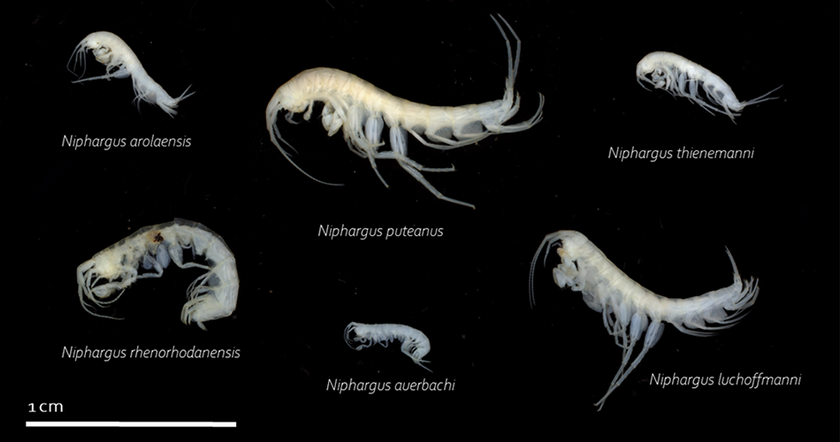News Detail
Land use influences organisms living underground
October 22, 2024 |
Four fifths of Switzerland’s drinking water comes from hidden underground aquifers. Numerous groundwater extraction sites tap into these reserves. Drinking water supplies are under increasing pressure. “In order to fulfil the quality criteria, some extraction sites have to be taken off the grid or water from impacted sites has to be mixed with less impaired water,” says aquatic ecologist Mara Knüsel, who is currently completing her doctorate in Professor Florian Altermatt’s research group at the aquatic research institute Eawag and the University of Zurich.
In recent years, Knüsel and her colleagues have been working intensively on researching small creatures that are at home in dark and cold water: groundwater amphipods. They resemble tiny shrimps, but unlike the differently pigmented freshwater amphipods on the surface, they are white and blind. They play an important role in the function of groundwater ecosystems.
Less nitrate at groundwater extraction sites surrounded by forests
In their latest article, which has just been published in the journal Ecological Applications, the researchers link the occurrence of amphipods to the type of land use on the Swiss Central Plateau. The researchers often found amphipods at groundwater extraction sites in the middle of a forest, whereas they encountered amphipods much less frequently at groundwater extraction sites near farmland. The groundwater at the extraction sites close to crops also tended to be more contaminated with nitrate than at the sites surrounded by forest, which indicates poorer drinking water quality.
However, Knüsel’s colleague Roman Alther points out that it would be premature to conclude that the water quality is poor because amphipods are absent. “Hydrogeology also plays a role,” he explains. “Factors such as the structure of the local groundwater aquifer, including pore size and water chemistry, can also influence whether or not amphipods are present.” The researchers therefore regard the presence or absence of the small organisms more as a supplementary indicator. “As an indication that the biology at a particular location may be impaired,” says Alther.
Influence of farmland still found within a distance of up to a kilometre
The researchers also show that the type of land use has an impact on the occurrence of amphipods in a larger radius. In the data set, farmland located 600 to 1,000 metres away from the groundwater extraction site also leaves a negative signal in the groundwater. In Switzerland, the Water Protection Act stipulates that protection zones must be created around groundwater extraction sites in order to protect valuable drinking water from contamination and other harmful influences. On the Swiss Central Plateau, however, these protection zones cover an area that extends on average only 300 to 400 metres around the extraction site. “We conclude that the currently established protection zones may not be large enough to prevent possible negative effects of land use on groundwater communities,” the researchers state in their article.
The effect of land use on the groundwater fauna (green line) changes with the distance from the groundwater extraction site (x-axis). This also applies at a distance where there is practically no groundwater protection zones (blue line). (Chart: modified according to Knüsel et al. / http://doi.org/10.1002/eap.3040)
A unique habitat
Just like lions in the savannah, amphipods in groundwater are at the top of the food chain. As a result, they also influence all other living organisms at lower trophic levels. “The great diversity of life forms in groundwater is still largely unexplored,” says Knüsel. The researchers have therefore only just laid the foundations with their data set on amphipods: their findings could be an argument in favour of a possible extension of the groundwater protection zones. Beyond this, they are keen to “raise awareness among the general public that groundwater is not only a precious drinking water reserve,” says Alther, “but also a unique habitat that needs to be preserved.”
New findings about amphipods
The Eawag researchers worked closely with water supply managers who are responsible for over 900 different groundwater extraction sites throughout Switzerland and “without whose help this work would not have been possible,” as Mara Knüsel emphasises. The collaboration resulted in a systematic collection of amphipods, in which the researchers also discovered several previously unknown species with the help of genetic analyses. The researchers also traced how the last ice age around 20,000 years ago affected the spread and the present occurrence of groundwater amphipods. “We find some species only in places that were not glaciated,” says Knüsel.
Groundwater fauna in Switzerland
The aim of the AmphiWell project is to record and document the occurrence of groundwater organisms at extraction sites throughout Switzerland. In order to collect as much data as possible throughout Switzerland, Eawag researchers work together with water supply managers.
Cover picture: Farmland or forest? Researchers found amphipods less frequently at groundwater extraction sites located near farmland than at those in the middle of a forest (Photo: Wikimedia, Adrian Michael).
Original publications
Knüsel M, Alther R, and Altermatt F. Terrestrial land use signals on groundwater fauna beyond current protection buffers. Ecol Appl. (2024). http://doi.org/10.1002/eap.3040
Funding / Partnerships
- Eawag
- University of Zurich
- University of Ljubljana, Slovenia
- Federal Office for the Environment (FOEN)
- Swiss Gas and Water Industry Association (SVGW)
- Swiss National Fund




